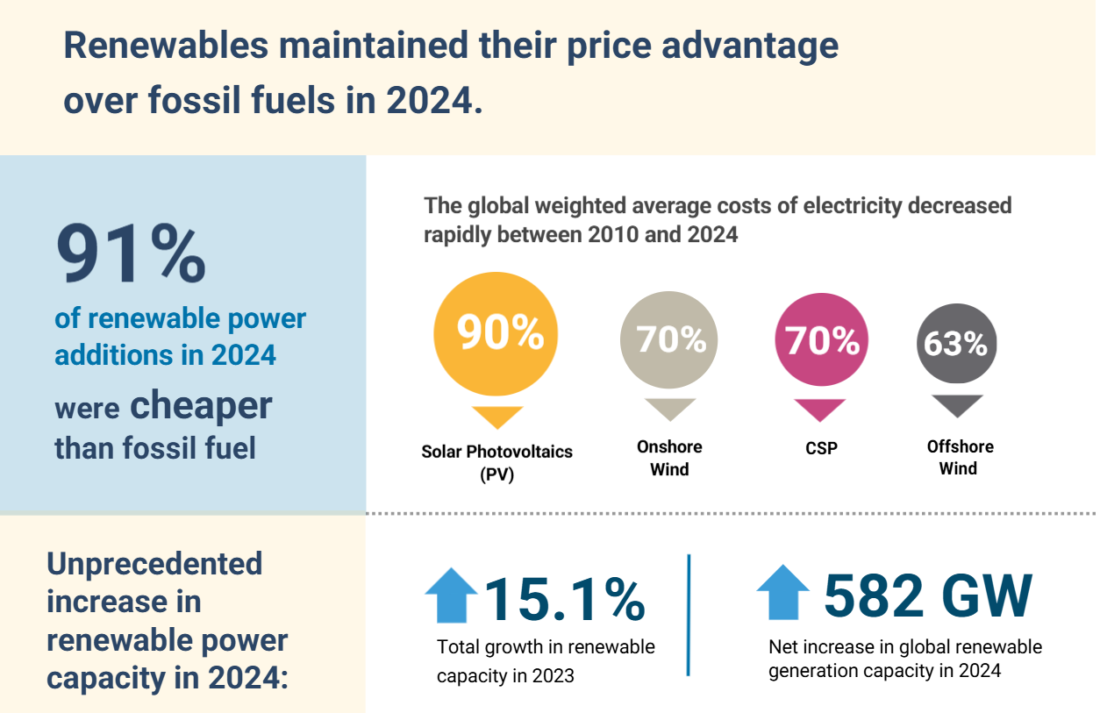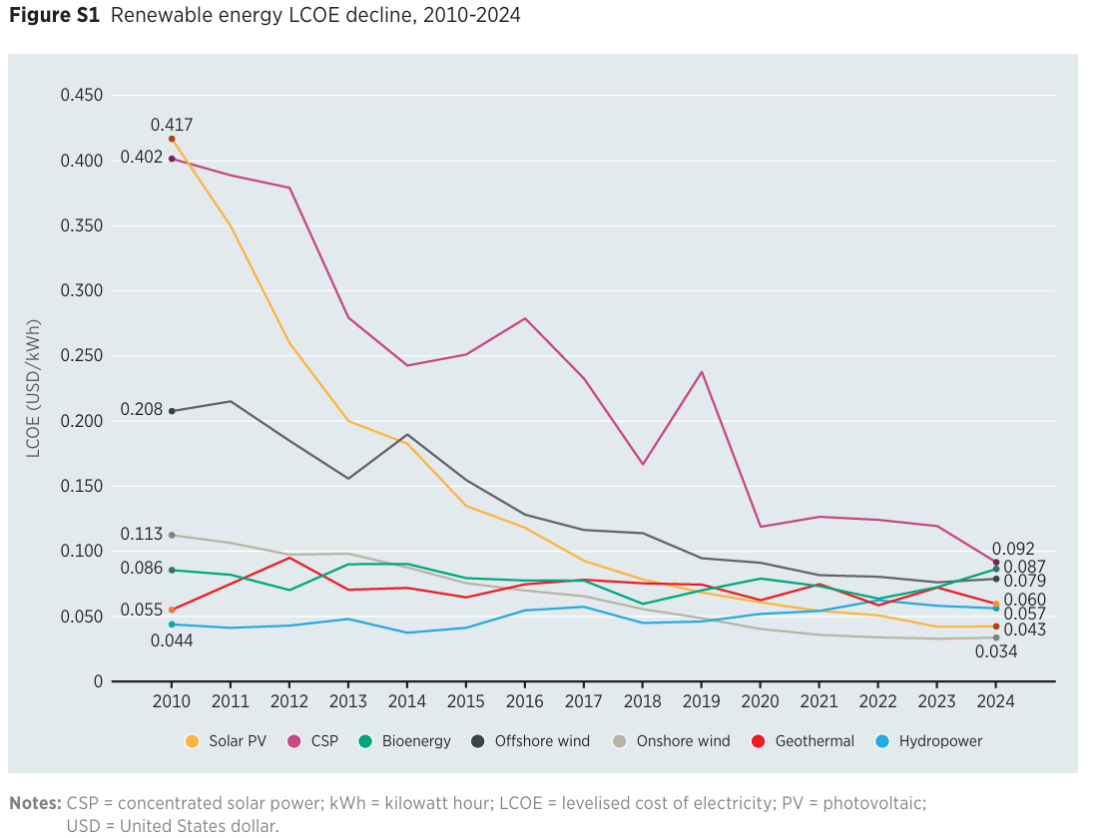On July 22, 2025, the International Renewable Energy Agency (IRENA) released the report “Renewable Power Generation Costs in 2024”, which analyzes changes in the costs of energy generation from renewable sources, and details the present state of renewable energy worldwide along with global trends and future predictions.
The report concludes that renewables continued to be the most cost-competitive source of new electricity generation in 2024 relative to all fossil fuel alternatives, and that data from IRENA’s renewable cost database, paired with an analysis of recent power sector trends, reaffirm renewables’ central role in achieving climate objectives in addition to their growing cost-competitiveness.
Following is a summary of some of the main conclusions of the report:
Renewable power generation is expanding at an all-time high
- In 2024, global renewable power capacity additions reached an unprecedented 582 gigawatts (GW), representing a 19.8% increase compared to the capacity additions delivered in 2023 and marking the highest annual expansion since records began in 2000. Solar photovoltaics (PV) led this surge, accounting for 77.8% of the total, followed by wind (19.6%).
- Increased renewable energy integration is shifting fossil fuel generation to peak or residual demand, reducing thermal plant use and exposure to volatile fuel markets. By 2024, solar and wind comprised 46.4% of global installed electricity generation capacity, significantly displacing coal and gas in key markets like China, the United States and the EU, and reducing associated greenhouse gas emissions.
- In the European Union, solar generation surpassed coal for the first time in 2024, while clean sources overall accounted for more than two-thirds of total generation. In the United States, solar and wind generation combined grew at an average rate of 12.3% per year in 2018-2023, while coal generation declined by an average of 10.2% each year over the same period. These trends point to a structural transition away from fossil fuel-based power generation, enabled by supportive policies, falling technology costs and rising electrification.
Renewables are significantly cheaper than even the cheapest fossil fuels
- Renewables continue to be the most cost-competitive source of new electricity generation; on a basis of LCOE (levelized cost of electricity, the average net cost of electricity generation over a generator’s lifetime), 91% of new renewable power projects commissioned in 2024 were more cost-effective than any fossil fuel-fired alternative.

- Between 2010 and 2024, total installed costs (TIC) declined sharply across major renewable technologies. Total installed costs for renewable power decreased by more than 10% for all technologies between 2023 and 2024, except for offshore wind, where they remained relatively stable, and bioenergy, where they increased by 16%.
- By 2024, the global weighted average LCOE for utility-scale solar PV was 41% cheaper than the cheapest fossil fuel-fired alternative, and onshore wind 53% lower than fossil fuel-based generation. Additionally, the economics of new dispatchable hydropower, geothermal and concentrated solar power (CSP) technologies improved in 2024. However, the LCOE of bioenergy increased by 13% in 2024 due to volatile feedstock and logistics costs.
- In 2024, renewables helped avoid USD 467 billion in fossil fuel costs, reinforcing their role in enhancing energy security, economic resilience, and long-term affordability. This includes $17 billion USD in avoided fossil fuel costs in Japan due to renewable energy generation. Globally, new onshore wind projects remained the cheapest source of renewable electricity, followed by new solar photovoltaic (PV) and new hydropower.
- The full value of renewables extends far beyond the LCOE, encompassing long-term energy security as well as public health and environmental sustainability. In addition to low energy generation costs, expansion of renewables can drastically reduce the need for costly infrastructure related to fossil fuel extraction, transport and backup generation while limiting dependence on international fuel markets and improving energy system resilience.
Renewables will continue to become cheaper in the future
- Looking ahead, total installed costs are projected to decline further, as learning rates and economies of scale continue to drive efficiency gains. For both solar PV and onshore wind technologies, Asia is set to retain a distinct cost advantage.

- As renewable capacity is expected to increase in the coming years to meet climate goals, battery storage, hybrid systems and digitalisation will all be critical enablers of the energy transition and the integration of variable renewables (solar PV and wind).
- From 2010 to 2024, the total installed cost of utility-scale battery energy storage systems (BESS) dropped by 93%. Hybrid systems, combining solar PV or wind with battery storage, are becoming standard in many markets, offering firmer output profiles, and improved capacity factors.
- Digital technologies – predictive maintenance, real-time performance monitoring, AI-enabled asset management, etc. – are improving operational efficiency of renewables, allowing for lower operation and maintenance costs and extended lifetimes, especially for solar PV and onshore wind.
Renewable growth still faces challenges
- The growth in renewable power capacity additions reflects the accelerating global momentum to increase the share of renewables in electricity generation. However, current deployment levels fall short of the goal set at COP28 to triple renewable energy capacity worldwide by 2030.
- While long-term cost reductions of renewables are expected, emerging geopolitical risks – notably trade tariffs on renewable components and materials and Chinese manufacturing sector dynamics – could raise costs in the short term.
- Financing costs remain a key determinant of renewable project viability, with capital costs shaped by factors such as revenue certainty, capital structure and macroeconomic conditions.
- While the plant-level solar and wind costs continue to fall, grid constraints are increasingly limiting their deployment. A substantial volume of wind and solar projects worldwide are facing delays due to grid connection bottlenecks, while long procurement lead times for key components are further affecting project timelines. These delays contribute to integration costs, along with costs associated with storage, and infrastructure development (for both curtailment and transmission). Investments in such assets not only enhance grid flexibility, but also benefit the entire power system, non-renewable generators included.
The report concludes that renewable energy is economically viable and easy to introduce, and that renewable energy’s continued growth is further lowering its prices. It also points out that in order to promote investment in renewable energy projects, it is essential to reduce the risk of financing and establish policies and mechanisms that ensure stable returns.
On the same day as the report’s release, UN Secretary-General António Guterres highlighted the IRENA report in a special address on climate action. He emphasized that the transition to renewable energy will provide people with a safe source of energy and explained how a just transition from fossil fuels to renewable energy is essential, stating “we are on the cusp of a new era. Fossil fuels are running out of road. The sun is rising on a clean energy age; just follow the money.”
The video and transcript of Guterres’ speech “A Moment of Opportunity” can be accessed here.
Renewable Power Generation Costs in 2024
IRENA News Article
Report download Link (PDF)
Media Briefing(PDF)
Reference : IRENA “Renewable Capacity Statistics 2025” Link
Written/published by: International Renewable Energy Agency (IRENA)
Published: July 22, 2025
